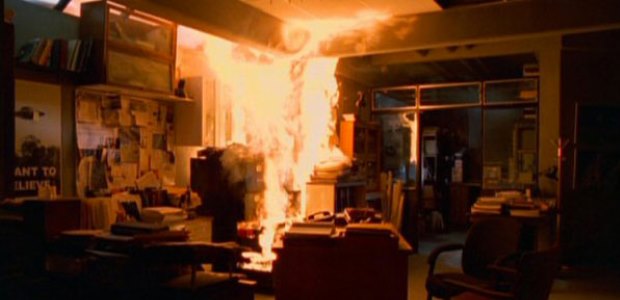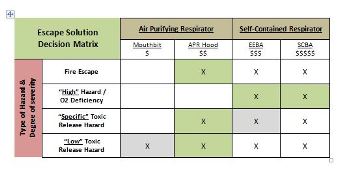
A New Approach to Escape Respirators
You can find the point where reduced cost and increased safety align.
- By Alex Gaggin
- Jul 01, 2014
Newton's first law of motion states that an object at rest remains at rest, while an object in motion stays in motion at the same speed and direction unless acted upon by an unbalanced force. In the world of safety, the same principle can apply to the types of respirators used for industrial escape applications. Although innovative technology has been revolutionizing industrial operations and efficiency for decades, many companies are still using the same escape solutions that were available 30 years ago. Considering the cost pressures facing today’s industry, it makes sense for companies to explore new escape solutions that can help reduce costs while still increasing safety standards.
When Considering Change Makes Sense
Escape respirators, like a compressed air emergency escape breathing apparatus (EEBA), will always serve an important role for certain applications. There is no substitute for EEBAs when oxygen levels are below 19.5 percent volume and atmospheres contain unknown or excessively high toxic concentrations.
On the other hand, EEBAs are also being utilized in many applications where a hazard analysis has eliminated the risk of oxygen deficiency and clearly identified the peak concentrations of the hazard. In these applications, there are additional NIOSH-approved technologies to consider, such as an air purifying respirator (APR) escape hood. A drawback to EEBAs is that they are heavy and bulky, so they are often stored versus carried. As a result, it can take workers additional time to access their escape respirator, or they may even leave it behind. Furthermore, most EEBAs provide only a maximum of 5-10 minutes of escape time once donned and come at a significantly higher cost than other alternatives.
Similarly, mouthbit escape respirators are a reliable, less-expensive option for protection against lower-concentration acid gas or ammonia hazards. Their small size makes them easy to access in an emergency, but they are approved for use with only a couple of hazard types. Furthermore, mouthbits severely impede verbal communication and do not offer any eye protection. This can pose a serious health risk around hazards such as chlorine that also affect eyes. In the past, these shortfalls have forced companies to rely heavily on costlier EEBAs.
New Escape Alternatives
Today, there are also NIOSH-approved APR hood solutions that can offer attractive cost savings and safety benefits to users. While APR hoods cannot be used in oxygen-deficient environments or excessive toxic concentrations, they are very effective at providing escape protection against a wide range of gases, vapors, and particles at a fraction of the cost compared to compressed air. Unlike EEBAs, APR hoods are smaller and lightweight, which means they can be put on quickly and belt-worn for fast access.
If users can immediately retrieve and easily wear a respirator, it increases the probability of workers using the device during an emergency. The hood design also mitigates the communication challenges associated with mouthbits and provides appropriate eye protection against corrosive hazards. So, once one is donned, the user can continue to speak and maintain a clear field of view.
Performing a Process Hazard Analysis
If companies are interested in determining whether a new solution is right for their workplace, the first step is to perform or review the process hazard analysis (PHA) to identify the risks present.
While there are many industrial hazards and risks, this article focuses on the two most common types of industrial hazards that present a high risk to the human respiratory system:
- Fire is a risk in virtually every industrial setting, but the greatest danger occurs when personnel are exposed to accumulating smoke. Most fire-related deaths are due to carbon monoxide poisoning, not burns. Any industry using high heat processes or flammable materials should be well prepared for fire hazards.
- Toxins include the release of a chemical, vapor, or gas from a process or vessel at high concentrations. The toxins are typically known because they are identified by the PHA. For example, hydrogen sulfide could be released from an oil drilling rig, or toxins such as chlorine, phosgene, or ammonia can be released from a chemical process.
Once the type of risk has been identified, the next step is to understand the degree of severity that would accompany a particular emergency situation. For the purpose of this article, the degree of severity is classified according to the definitions of high, specific, and low established by NIOSH's document, "Concept for CBRN Air-Purifying Escape Respirator Standard."
High: Any scenario involving a release or existence of unknown toxic substances in high or unknown concentrations, as well as oxygen-deficient atmospheres (less than 19.5 percent volume)
Specific: Any scenario involving the release or existence of known toxic substances in any concentration (environments with "specific" hazards always have sufficient oxygen)
Low: Any scenario involving the release or existence of known toxic substances in low concentrations (environments with "low" hazards always have sufficient oxygen)
Selecting the Best Respirator for the Application
 Once the risks have been clearly identified, the final step is to consult a decision matrix to identify all of the options available. Unfortunately, when it comes to escape respirators, there isn't a one-size-fits-all optimal solution. All respirators have pros and cons that must be carefully considered before making a decision.
Once the risks have been clearly identified, the final step is to consult a decision matrix to identify all of the options available. Unfortunately, when it comes to escape respirators, there isn't a one-size-fits-all optimal solution. All respirators have pros and cons that must be carefully considered before making a decision.
Self-contained apparatus can be used for any application, but they are significantly more expensive and maintenance intensive. As a result, they also tend to require more time, training effort, and labor to keep the equipment in good working condition. Mouthbits are small and inexpensive, but have limited approvals and present some safety challenges. APR escape hoods help bridge the gap between mouthbits and EEBAs within the fire escape and "specific" or "low" toxic release applications. In those scenarios, ARP hoods offer a rare value, which is the ability for customers to spend less money on a product that is better suited for a specific safety need.
Companies that actively identify the hazards that present the greatest work site risks not only streamline workflow and protect their bottom lines, they most importantly protect their greatest assets—the lives of their workers.
This article originally appeared in the July 2014 issue of Occupational Health & Safety.